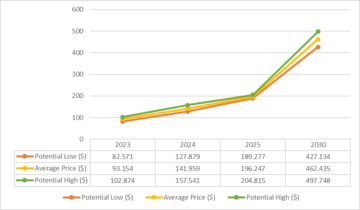Cryptocurrency has grown into an international market that’s nearing a total value of $2 trillion USD. During the highs and lows of this process of growth, many new applications and strategies of investing have arisen from cryptocurrency.
While originally, the strategy for making money with cryptocurrency was to hold it as the asset increased in value, more and more investors are turning to alternative streams of income.
One of these is staking, where a user can gain interest in their currency while still retaining the coins. Always trying to maximize profit, further innovations stemmed from staking, with leveraged staking now being a common practice to boost profit and turn cryptocurrency into a passive stream of income.
In this article, we will explore what cryptocurrency staking is, detailing how leveraged staking works, and demonstrating how you can get started with this form of crypto income.
What is Cryptocurrency Staking?
Staking a cryptocurrency is the action of entering your coins into a contract where they’ll start to earn an interest rate over time.
Many cryptocurrencies rely on a Proof of Stake protocol, where each transaction that passes through their system is verified without a middle institution.
When staking your cryptocurrency, your funds become the middleman for these transactions, helping that specific cryptocurrency to function as efficiently as possible.
As a reward for helping that coin increase its functionality, you are then rewarded with a fixed interest rate.
Typically, staking is split into 30-, 60-, and 90-day periods of locking your currency away. As the time period extends, the total reward that you get for staking that cryptocurrency will increase.
Especially with fairly new cryptocurrencies that need an influx of staked currency in order to get their operation to the desired level, users can expect to see two or even three-figure percentage returns on their capital.
People who stake their cryptocurrencies are able to turn this digital asset into a form of passive income, generating a steady return on the amounts they’ve entered into the staking pools.
What is leveraged staking?
In trading in general, leveraged trading – also known as margin trading – is the act of using borrowed money to increase potential returns.
For example, while a 20% return on $100 would be a $20 profit, if the user had increased their $100 investment through leverage trading, let’s say by 100x, then suddenly that $20 profit would have been $2000.
In short, leverage trading is increasing the potential returns (and therefore also the losses) that you can get on trade. Within cryptocurrency, leveraged staking is where a user will borrow money from a DEX and then use that currency to enter into a staking agreement.
If the percentage return on the staking agreement is larger than that of the cryptocurrency, then the investor is set up to gain from the arrangement.
With this assured, the investor is set to increase their profits while providing a long-term stream of income through leveraged staking.
What are the benefits of leveraged staking?
One of the central benefits that people cite when discussing this form of staking is increased income. Of course, staking a larger amount of a currency will ensure that the percentage return brings you back a higher quantity of tokens.
The more you invest, the more a percentage return will actually return.
With leveraged staking, as you’re able to borrow assets and then stake them, you’ll be gaining even more currency. Additionally, the second major benefit is that this is a completely passive form of income.
Once you’ve done the initial calculations to ensure that your loan repayment rate is lower than the return you’ll be getting from your leveraged staking, you’ll then be able to stake the currency and leave it there.
Without a need to continually change, edit, or make additional trades, this is one of the easiest ways of turning cryptocurrency into an arena for passive income.
How do I go about leveraged staking?
Leveraged staking can be achieved on any decentralized exchanges, with the majority of the platform leaders offering pages where you can take out crypto loans.
By ensuring that the rate of return is higher than that of what your loan will charge you, you can effectively ensure a stable return on your staking.
However, if your cryptocurrency were to diminish or something were to go awry, you would be leaving yourself very vulnerable to the loan repayment, potentially racking up a debt with the exchange.
As many users that wanted to turn to leveraged staking ran into this problem, platforms have sprung up that directly accommodate.
One of these, Parallel Finance, is a decentralized money market that allows users to borrow, stake, and lend through the Polkadot ecosystem.
One of the features of Parallel Finance is the ability to leverage stake, with users being able to both stake on Polkadot while also lending out their staked tokens to the in-app liquidity pool.
Instead of just earning a single income of yield, this effectively doubles the potential returns that investors can expect to see. One income comes from the staked yield, while the other comes through the liquidity pool.
A user will also be able to add to the leverage pool in quantities that fit their risk profile, not having to allocate all of the staked currency at once.
With this flexibility, Parallel Finance ensures that users can scale their leveraged staking to directly match the amount of risk they’re willing to take.
This innovative style of leveraged staking ensures that users have more control over their assets while also being able to receive high-yield returns from two simultaneous sources.
Final Thoughts
When looking to begin leveraged staking, it’s always advisable that you heavily research the asset that you’re investing in.
While some altcoins offer high return interest rates, they could do so in a style of rug-pull. Especially if an asset is very new, you’re always better off doing your due diligence before plowing on into investing.
That said, if you want to offset some of the risks of borrowing crypto from major exchanges, then investors can’t find a much more fitting solution than Parallel Finance.
Built to specifically support lending, staking, and borrowing, this innovative tool will allow you to make the most of leveraged staking on Polkadot.
- 100x
- About
- achieved
- Act
- Action
- Additional
- Advertisement
- Agreement
- All
- Altcoins
- amounts
- applications
- article
- asset
- Assets
- become
- before
- being
- benefits
- Borrowing
- Can Get
- capital
- change
- charge
- Coin
- Coinpedia
- Coins
- Common
- completely
- contract
- could
- crypto
- cryptocurrencies
- cryptocurrency
- Cryptocurrency Staking
- Currency
- Debt
- decentralized
- Dex
- digital
- Digital Asset
- diligence
- during
- Earning
- ecosystem
- entered
- especially
- example
- exchange
- Exchanges
- expect
- Features
- finance
- fit
- Flexibility
- form
- function
- functionality
- funds
- General
- getting
- Growth
- having
- helps
- High
- hold
- How
- HTTPS
- Income
- Increase
- increased
- innovative
- Institution
- interest
- Interest Rates
- International
- investing
- investment
- investor
- Investors
- IT
- known
- larger
- LEND
- lending
- Level
- Leverage
- Liquidity
- loan
- Loans
- looking
- major
- Majority
- Making
- margin trading
- Market
- Match
- money
- more
- most
- offer
- offering
- offset
- order
- Other
- People
- percentage
- periods
- platform
- Platforms
- Polkadot
- pool
- Pools
- possible
- Problem
- process
- Profile
- Profit
- profits
- protocol
- Rates
- receive
- research
- returns
- rewarded
- Risk
- risks
- Said
- Scale
- set
- Short
- simultaneous
- So
- something
- specifically
- split
- stake
- Staked
- Staking
- start
- started
- strategies
- Strategy
- stream
- streams
- style
- support
- system
- The Coins
- Through
- time
- Tokens
- tool
- trade
- trades
- Trading
- transaction
- Transactions
- use
- users
- value
- Vulnerable
- What
- WHO
- within
- without
- works
- would
- Yield













